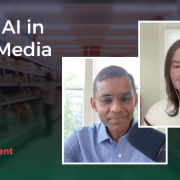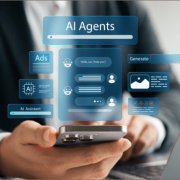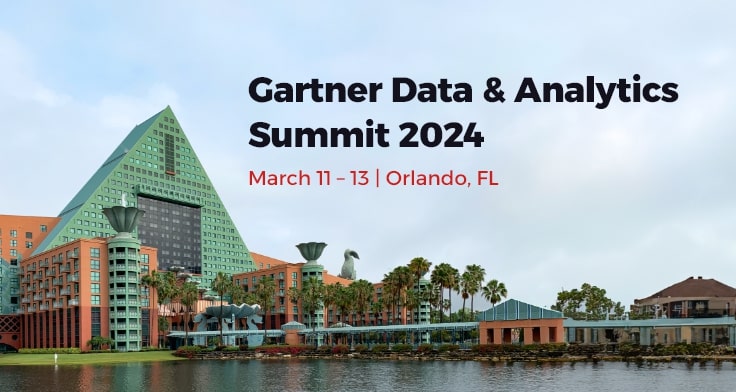I had an opportunity to participate in the 2024 Gartner Data & Analytics Summit in Orlando. This year’s event had something for everyone, with plenty to choose from. Their six tracks focused on D&A leadership, business value, analytics, AI, data management, and governance. I look forward to such events to learn and engage with various customers, analysts, speakers, exhibitors, and industry peers. Here are ten learnings that stuck with me from the conference mixed with my own reflections:
1. D&A Leaders must work with their CEOs to establish & execute their AI Ambition.
AI is fast becoming a general-purpose technology, much like the Internet. Companies that integrate AI into their redesigned business workflows are more likely to win in the long term than companies that use AI for incremental improvements. According to Gartner, public companies that strategically use AI outperformed their peers 80% of the time over the past nine years. Yet, 90% of leadership is not AI-ready.
D&A leaders must collaborate and collectively define their company’s AI ambition—is it a business driver or a business enabler? Then, work on the foundational pillars, which include skillset, toolset, mindset, dataset, and trustset. A successful practitioner states that success is 97% execution and 3% strategy. Think big, start small, and scale quickly!
2. Executive Leadership will be tested when prioritizing AI innovation alongside new regulatory mandates against AI harms.
Companies operating in multiple countries face regulations based on diverse principles reflecting local political norms and cultural differences. The US favors a light-touch regulatory approach to foster AI innovation, the EU emphasizes stringent risk-based regulations for AI, and China favors a proactive approach to addressing AI risk within specific topics such as algorithms and deep synthesis over time.
Executives must lead with a dual focus: embracing the transformative power of AI while also championing the safeguards that keep its development in check. Recommendations to leaders include adding AI-related questions to third-party due diligence, monitoring regulations, assessing risks, and tracking unauthorized and prohibited uses.
3. The confluence of AI & BI will require D&A leaders to reimagine why they do what they do for business.
The bake-off between Microsoft Power BI, Oracle Analytics Cloud, and Tableau was very interesting. It was useful to see scripted demos from their experts on data management, analysis, content creation and collaboration, sharing, and emerging innovations. Microsoft showcased co-pilot for (almost) everything, Oracle impressed with ambient analytics, and Tableau envisioned a spatial canvas for visuals.
AI’s automation power can be used to develop point solutions that produce the same output but faster through improved developer productivity, as showcased by Microsoft. Or it can fundamentally transform how analytics are delivered for business use, as showcased by Oracle. Does your business need the same old mousetrap, just built faster, or a better mousetrap?
4. McDonald’s Way: Starting with technology to govern enterprise data & AI doesn’t work at scale.
Zachary Richard, who heads McDonald’s Global Data Science team, shared an insightful case study on how they went about successfully building an enterprise data & AI modeling governance platform after two failed attempts in the past five years. The platform, powered by Collibra, provides better discoverability, easier collaboration and reduces risk while improving horizontal ways of working with trustworthy data.
The critical success factors included spending time talking to market leads to build a business context for the program, building a business-led story on the business value of the platform, strong partnership between business & IT leadership, and taking a “front back” approach to technology selection. They are using a hub-and-spoke model to integrate market systems with the enterprise platform.
5. The Generative AI wave is driving (meaningful) innovation in product companies with niche core capabilities to support RAG-based use cases.
Retrieval-Augmented Generation technique combines a pre-trained LLM with a retrieval system to provide the LLM with access to contextual and trustworthy data for more relevant responses. It is favored over fine-tuning, which takes more time and money, and is especially not good when enterprise facts change frequently. Implementing RAG at an enterprise scale is not easy when one custom codes apps.
It requires organizing enterprise facts for effective retrieval using either a vector database (for similarity) or a document hierarchy (for relatedness). This is done through chunking and embedding data when storing and vice versa when retrieving. Tools such as Nexla (RAG pipelines & orchestration), Aible (serverless full-stack apps), and Neo4j (knowledge graph) are making it easier to build Gen AI apps.
6. Companies are (finally) prioritizing enterprise data quality practices.
The ability of a business to generate and scale ANY value from AI depends on how well it takes advantage of its data. Access to large quantities of high-quality data is a prerequisite and a top barrier to the adoption of AI. While everyone wants to do the glamorous work of showcasing AI models, only some want to do the hard work of engineering quality into their data.
I had several conversations with leaders from large enterprises who were in the market to explore comprehensive data quality management solutions. This is a good sign. Tools such as DQLabs and Monte Carlo support proactive quality management practices with multiple interventions – both human & automated – into the data lifecycle from source to enrichment to consumption.
7. Study working practices & lessons learned from companies that accelerated Gen AI results.
Two real-world case studies on the successful use of Gen AI caught my attention:
- Scott Richardson, CIO at Ally shared how they achieved real business results, with velocity to market being their primary driver, and
- Darrel Cherry, Chief Architect at Clearwater Analytics, shared how they delivered CWIC to provide digital specialists to their clients to transform client interaction with accounting data.
When the industry’s overall maturity is low, it helps to learn from others. Ally incrementally built an enterprise platform with loosely coupled components and established an AI factory model for delivery. Clearwater articulated a similar architecture but with more granular security controls. A focus on MVP, engineering culture, quality data, responsible AI, and change management was crucial in their success.
8. Deploying AI at scale requires mastery of ModelOps, DataOps, and DevOps.
Delivering value from Gen AI requires deployment at scale. The non-deterministic nature and black-box characteristics of predictive results creates multiple challenges – from lack of transparency and consistency to higher and more skillful resource requirements for operations and model management. No wonder most (>54%) projects fail, never go into production, or take forever.
Data engineering has roots in software engineering, and both have evolved into distinct disciplines with different focus. Now, AI engineering is fast evolving. Digital teams would need skills from each discipline to solve problems. DevOps would enable software agility, DataOps would enable dealing with data variability, and ModelOps would be essential for model consistency.
9. Should you worry about making the right decision or making your decision right?
Building modern enterprise AI applications requires a leader to make several choices. Examples include selecting an LLM, provisioning infrastructure, choosing from literally 100s of tools, build or borrow talent, prioritizing use cases, and many more. The paradox of choice leads to stress, difficulty in making decisions, and a higher chance of regret.
I wonder if leaders are spending more time worrying about making the right decision than focusing on execution as demonstrated at Ally Financial. Infocepts envisions a productized solutions approach to precisely mitigate such risks in enterprises. When things are evolving quickly, you must have the ability to change the underlying technology without impacting your business workflows.
10. As we make AI smarter, we must invest in how we remain smarter.
Lastly, two keynotes from guest speakers intrigued me.
Rahaf Harfoush, a Digital Anthropologist, focuses on the intersection of emerging technology, innovation, and digital culture. She observes that as Gen AI becomes pervasive, humans risk losing the mastery of thinking, which is (very) dangerous. We are at the cusp of redefining the value of human creative labor. To counter that, we must build intentional systems of expertise to achieve our goals collectively with human and AI intelligence.
David Kwong, a Magician and NY Times Crossword Puzzle Constructor, gave a spellbinding talk on creating order out of chaos. He exhibited several tricks that made them look ridiculously easy, much like how AI generates content with ease. He quoted Teller: “Sometimes magic is just someone spending more time on something than anyone else might reasonably expect,” which alludes to the hard work that goes into making things appear simple! But according to David, the real magic is in the data that is behind the scenes.
The question is how much work are we willing to put in to make our business succeed with AI?
At the 2024 Gartner Data & Analytics Summit, the consensus was clear: AI and Data are vital for business success. Yet, the intricacies of AI present a formidable challenge. This is where Infocepts comes in. With our extensive expertise in AI and Data Management, we are well-equipped to address these challenges, ensuring you can leverage AI’s potential in a safe and effective manner. Talk to us to commence your AI journey today.
Recent Blogs

The Future of Supply Chains Is AI-Driven—Is Your Business Ready to Embrace the Change?
July 2, 2025

What Retail Media Can Learn from Instacart’s AI Strategy
June 24, 2025

Beyond Chatbots: How Agentic AI Is Automating High-Stakes Business Decisions
June 11, 2025

From Batch to Real-Time: The Future of Data Distribution Using Databricks Delta Sharing
June 4, 2025


